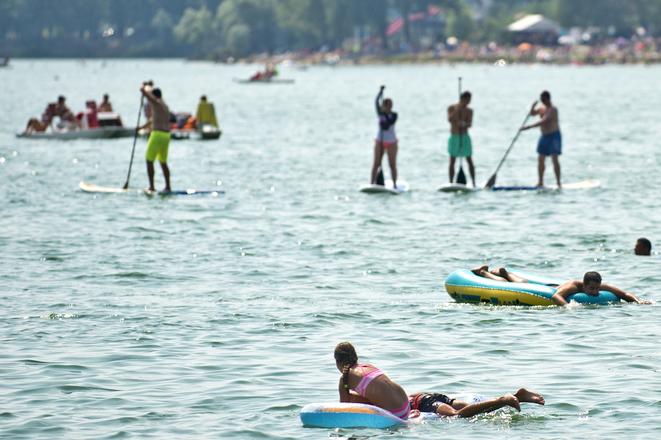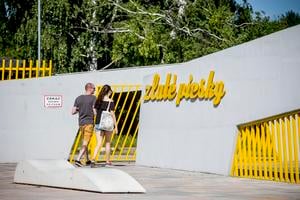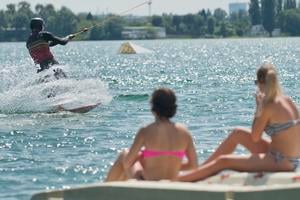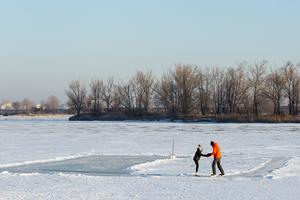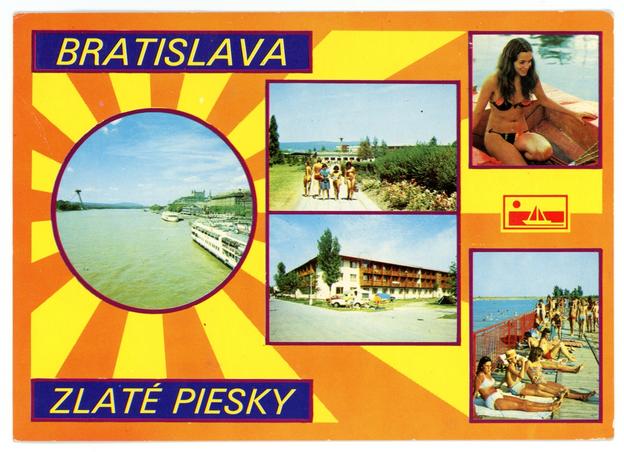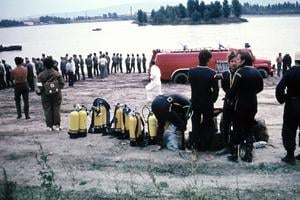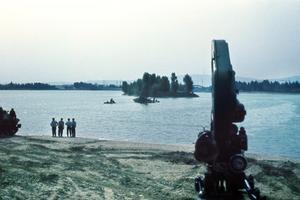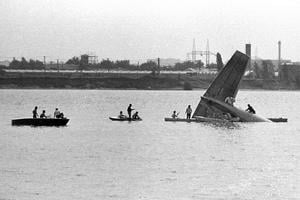Bratislava offers several places to cool off and enjoy summer. Apart from open-air pools like Tehelné Pole and Delfín, there are also lakes. The biggest of them is Zlaté Piesky, or Golden Sands, on the outskirts of the capital. It offers an official beach as well an unofficial one for nudists, stands selling lángoses or cigánska, a camp site, children’s playgrounds and many sports opportunities.
“One doesn’t need to go to Croatia to spend a holiday on a beach camp site by the Mediterranean Sea. They can similarly enjoy their time at the Zlaté Piesky camp site,” architect Martin Zaiček told The Slovak Spectator. Last summer, he and photographer Andrea Kalinová spent a week-long residence in this recreational zone with site-specific phenomena within their Abandoned (Re)creation initiative.
Zlaté Piesky now
The recreational area has 28 hectares and is administered by Bratislava’s Sports and Recreational Facilities Administration (STaRZ). This organisation also administers the entire lake, which is approximately 50 hectares. There is an elongated island measuring about 20 metres in its middle.
On the official paid beach visitors can rent water bikes or boats. There is also the toboggan, tennis, volleyball and basketball courts as well as a golf putting green. Those wanting to exercise can do so in the outdoor fitness park or in the street workout park. People can play football or mini football, table tennis or ascend a climbing wall, according to Michaela Velická, spokesperson of STaRZ. The lake is easily accessible by public transport: take from the city centre tram 4 to the end of the line, turn right, cross the street, and you are there.
“During summer, visitors can join the summer activities like pilates or dancing for children that are free of charge for visitors,” Velická told The Slovak Spectator. “A novelty this year is the shelters with grills that visitors can use the whole year.”
Next to the fenced recreational area, on the side of Senecká Cesta road, the Wakelake resort offers wakeboarding, including wakeboard cable, flyboard and other water sports.
Nude beach (FKK) in Bratislava
On the lake’s opposite bank, there is an unofficial beach used by nudists. There is a buffet and some parts of this beach are well attended but other areas resemble a brownfield with garbage. But since this is at the southern part of the lake, it offers sun in the evening compared to the official beach on the western side. The latter is under shade in the late hours of the day.
The lake is also a fishing preserve but fishing is not allowed on the official beach as well as on the beach going from the Vodník restaurant up to Wakelake from June 1 to August 31 between 9:00 and 18:00, according to Velická.
The resort is also a popular place for holding open-air festivals during the summer months.
In mid-June the media reported on a plan to build a new sports-recreational complex at Zlaté Piesky with shops and a swimming pool. The project is in its very early stages and for now an investor for it has not surfaced.
How it started
Similar to other lakes in the city and its surroundings, Zlaté Piesky began as a gravel quarry. The extraction of gravel for constructing the nearby airport and blocks of flats, called paneláky, began here sometime in the early 1960s or even the 1950s. On one side of the lake a concrete-panel plant was built to produce the panels to construct the blocks of flats.
But soon the site turned into a favourite place for bathing and resting for Bratislavans. The official, paid beach was launched in the early 1960s.
“The lake was named Zlaté Piesky [Golden Sands], probably after the popular resort in Bulgaria on the Black Sea,” historian Vladimír Tomčík told The Slovak Spectator.
The recreational zone acquired a fence and then the first changing rooms, showers and a cloakroom were built, as well as the first wooden stands serving sausages, cigánska [a slice of bread with pork, onion and mustard], colourful flavoured soda water, Kofola and warm beer in wax-coated paper cups, Tomčík recalled. The camp site was built in 1973. A hotel with 160 beds was later added.
Air crash
The promising development of the resort was interrupted by one of the biggest air disasters to occur in the former Czechoslovakia.
On July 28, 1976, a Czechoslovak Airlines plane flying from Prague to Bratislava crashed into the lake after a failed landing attempt at the nearby airport in Ivanka Pri Dunaji. Unfortunately, the plane struck the deep part of the lake, meaning that most passengers actually drowned. Of 79 passengers and staff, only four survived. The people who were at the beach at the time of the crash or those who had arrived from the nearby airport took boats and tore holes with axes into the rear part of the plane, jutting from the water. But one of those rescued died in the hospital due to injuries.
The state put the crash as well as investigation information on embargo and the resort remained closed for some years.
A memorial unveiled in 2014 marks the disaster.
The resort was gradually re-opened and its second development phase began. Cabins were added to the camp site, with a toboggan installed as well as various sports facilities.
Abandoned (Re)creation at Zlaté Piesky
The resort today maintains its official name from the previous regime – Areál Zdravia or Health Area in English – offering swimming and other ways of enjoying summer in somewhat of a retro style. Its actual development halted several years ago. Thus it maintains a little of the look from the end of the communist regime even though new toilets and some small improvements have appeared in the last few years.
During their residence Zaiček and Kalinová discovered that the place is highly used by Bratislavans as well as a surprisingly large group of foreign tourists.
“It is a fantastic place to relax and it is actually easily accessible from the city,” said Zaiček. “We don’t have any objections to its technical conditions even though the resort could deserve a bit more attention.”
Urban legends
Zlaté Piesky has also inspired the creation of several urban legends. One of the most known, but occurring all over the world, is that of the razor blades in the toboggan. These were allegedly stuck in the joints of the toboggan’s laminate parts by members of a marginalised group (Roma in Slovakia) as revenge against the majority, explained ethnologist Eva Šípoczová to FM Radio.
“But these stories are not true,” said Šípoczová.
Another urban legend, connected with the air crash, is that some of the people’s bodies who died in the crash were left in the part of the aircraft that remained in the lake. This part was taken out only around 2000. This one is also not true as the bodies were removed from the lake after the crash, according to Zaiček.
What next
In mid-June the media reported on a plan to build a new sports-recreational complex on Zlaté Piesky with shops and a swimming pool.
It has been prepared by the Slovak Technical University and the Podnikateľské Centrum Architektov (Business Centre of Architects) on the basis of an urbanistic study commissioned by the city council back in 2009. The new sports, recreational and accommodation facilities should be built on land the Nuss company of Bratislava bought in 2013, the Sme daily reported.
Now the Bratislava city council and the Ružinov borough council, where Zlaté Piesky is located, are evaluating the project.
For now there is no investor to finance the project.
In response to these plans the city council has so far said that it wants to maintain the recreational character of Zlaté Piesky.
STaRZ knows the project only from the media and is not participating in the project.
Zaiček is calling for a wider discussion on the development plans because places like Zlaté Piesky offering official and unofficial recreation are part of the city’s public places and freedom of usage enriches city life.


